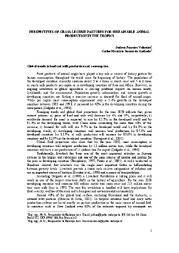Perspectives of grass-legume pastures for sustainable animal production in the tropics.
Perspectives of grass-legume pastures for sustainable animal production in the tropics.
Autoria: VALENTIM, J. F.; ANDRADE, C. M. S. de
Resumo: Traditionally, livestock has been one of the most important activities in farming systems in the tropics and one of the main sources of income and protein for the poor in developing countries. Nitrogen is the most nutrient in many agricultural ecosystems. The integration of legumes (herbaceous and trees species) can contribute to: 1) minimize external inputs, particularly nitrogen fertilizers, in agricultural ecosystems; 2) increase resource and land use efficiency in cattle production systems; and 3) mitigate global warming. In the introduction, this paper presents a review of the ongoing and projected global trends in beef and milk production and comsuption, with particular focus in the developing countries, most of wich are located in the tropics. Since beef and dairy cattle ranching in this region is based mostly on pasture production, in the following sections this paper focus the analysis of: 1) the potential of legumes for increasing profitability and promoting sustainability of the production systems; 2) the reasons for lack of wide adoption of grass-legume pastures by farmers; 3) success stories of on-farm wide adoption of grass-legumes pastures; and, 4) innovative strategies to ensure success of research and development and to promote on-farm utilization of grass-legume pastures in the tropics. The authors conclude that: a) grass-legume technologies are essential for adequate policy action to ensure that the ongoing Livestock Revolution can reconcile economic growth, poverty alleviation and environmental conservation in the tropics; b) there are good perspectives that currently avaiable and new technologies resulting from ongoing research will play an increasing role in sustainable cattle production in the region; c) the use of innovate strategies for research and transference of technologies are the key in promoting successful histories and wider adoption of grass-legume pastures, particularly by small farmers in the tropics; and, d) the use of participatory approaches and better integration with the beef and dairy prodction chains are recommended to overcome constant budget restrictions of public research institutions and also to ensure that grass-legume technologies developed are compatible with the economic, social e environmentalconditions that exist in the farms of the tropics.
Ano de publicação: 2004
Tipo de publicação: Artigo em anais e proceedings
Unidade: Embrapa Acre
Palavras-chave: Agricultura Sustentável, Desarrollo económico, Desenvolvimento Econômico, Ganado, Gramínea Forrageira, Granjas pequeñas, Leguminosa Forrageira, Leguminosas forrajeras, Pastagem, Pastizales, Pastos forrajeros, Pecuária, Pequeno Produtor, Producción animal, Produtividade, Produção Animal, Rendimiento de los cultivos, Rendimiento del forraje, Sistema de Produção, Tecnología de producción, Transferência de Tecnologia
Observações
1 - Por padrão são exibidas publicações dos últimos 20 anos. Para encontrar publicações mais antigas, configure o filtro ano de publicação, colocando o ano a partir do qual você deseja encontrar publicações. O filtro está na coluna da esquerda na busca acima.
2 - Para ler algumas publicações da Embrapa (apenas as que estão em formato ePub), é necessário ter, no celular ou computador, um desses softwares gratuitos. Sistemas Android: Google Play Livros; IOS: iBooks; Windows e Linux: software Calibre.
Acesse outras publicações
Acesse a Base de Dados da Pesquisa Agropecuária (BDPA) para consultar o acervo completo das bibliotecas da Embrapa.

